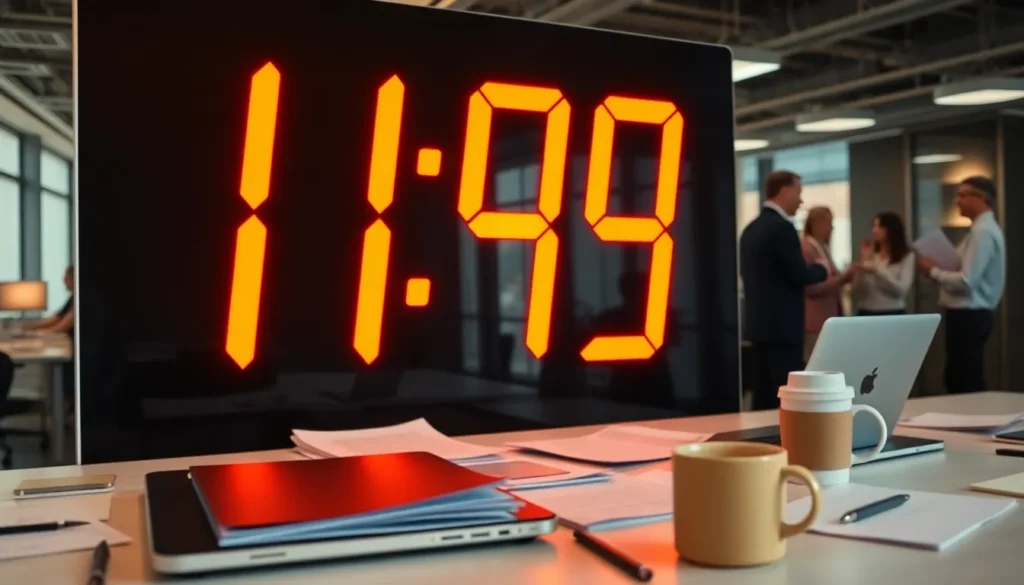Table of Contents
ToggleTime can often feel like it’s slipping away, especially when there’s a deadline or an event looming. As the clock ticks, the question “how long until 12:00 PM?” becomes crucial for planning and productivity. Knowing the remaining hours and minutes can help individuals prioritize tasks and make the most of their day.
Understanding the time left until noon isn’t just about counting down the minutes; it’s about maximizing efficiency. Whether it’s for work, school, or personal commitments, having a clear grasp of the time can lead to better time management and a more structured approach to daily activities. So, let’s dive into how to easily calculate the time remaining until that pivotal hour strikes.
Understanding Time Calculation
Time awareness plays a crucial role in daily activities and task management. Knowing the time until noon aids individuals in prioritizing effectively.
Importance of Time Awareness
Time awareness improves productivity and decision-making. People can allocate time for specific tasks, ensuring commitments are met and deadlines adhered to. For example, students often manage their study schedules by calculating the remaining time for assignments before noon. Similarly, professionals can plan meetings or project timelines based on the understanding of how long until noon.
General Time Formats
Common time formats include the 12-hour and 24-hour clocks. The 12-hour clock features AM and PM designations, while the 24-hour clock uses a continuous number format from 0:00 to 23:59. For instance, 10:00 AM on the 12-hour clock translates to 10:00, and 10:00 PM becomes 22:00 on the 24-hour clock. Recognizing these formats facilitates accurate time calculations for events scheduled before noon.
How to Calculate Time Until 12:00pm

Calculating the time remaining until 12:00pm is straightforward. This section outlines step-by-step methods to make calculations easy and highlights common mistakes that may occur during the process.
Step-by-Step Calculation
- Identify the current time: Observe the current time using a clock or device displaying time.
- Convert to a single format: If needed, convert the current time to either the 12-hour or 24-hour format for consistency.
- Calculate hours remaining: Subtract the current hour from 12, adjusting if the current time is past noon.
- Calculate minutes remaining: If the minutes have passed, subtract the current minutes from 60. If not, use the current minutes to determine how much remains in the hour.
- Combine results: Add the calculated hours and minutes to determine the total time until 12:00pm.
Common Mistakes to Avoid
- Forgetting to convert: Not converting time formats can lead to incorrect calculations. Always ensure time is in one format.
- Ignoring AM/PM distinctions: Misunderstanding AM/PM can result in errors when calculating times before or after noon.
- Focusing on minutes only: Solely concentrating on minutes without accounting for hours can lead to confusion.
- Rounding off errors: Rounding time before calculating minutes can yield inaccurate results. Always use exact values.
- Misjudging the current time: Misreading the clock can cause significant errors in calculation. Double-checking the current time reduces miscalculations.
Time Zones and Their Impact
Understanding time zones is essential for accurate calculations of the time until 12:00 PM. Time zones can greatly influence the remaining hours and minutes until noon, depending on one’s location around the globe.
How Time Zones Affect Calculation
Time zones divide the world into regions that observe standard time. Each zone typically represents a one-hour difference from its neighboring zones. For example, if it’s 9:00 AM in Eastern Standard Time (EST), it’s already 6:00 AM in Pacific Standard Time (PST). Individuals need to account for these differences when calculating the time left until noon. Adjusting for time zones ensures a precise understanding of how far one is from that midday milestone.
Examples from Different Regions
| Region | Current Time | Time Until 12:00 PM |
|---|---|---|
| Eastern Standard Time (EST) | 9:00 AM | 3 hours |
| Central Standard Time (CST) | 8:00 AM | 4 hours |
| Mountain Standard Time (MST) | 7:00 AM | 5 hours |
| Pacific Standard Time (PST) | 6:00 AM | 6 hours |
| Greenwich Mean Time (GMT) | 2:00 PM | -2 hours (passed noon) |
These examples illustrate how one location may be approaching noon while another is significantly earlier in the day. Recognizing these regional differences facilitates better planning and time management, aligning schedules and commitments effectively.
Practical Applications of Time Calculation
Understanding the remaining time until noon plays a vital role in various everyday scenarios and effective planning. This awareness enhances productivity and helps individuals manage their commitments efficiently.
Everyday Scenarios
Individuals benefit from calculating time until 12:00 PM in numerous daily situations.
- Work Meetings: Employees can ensure they arrive punctually by knowing how much time is left before a scheduled meeting.
- School Classes: Students can plan their study time and ensure assignments are completed before class starts.
- Errands: People can efficiently organize tasks, such as grocery shopping, by calculating how much time is available before noon.
By integrating time calculations into these everyday scenarios, individuals can better prioritize activities and reduce stress.
Scheduling and Planning
Effective scheduling relies on understanding the time remaining until noon.
- Task Allocation: Individuals can assign specific durations for tasks, allowing for smoother transitions between activities.
- Meeting Coordination: Knowing the time until noon helps synchronize meetings, ensuring participants are available and on time.
- Deadline Management: Time calculations assist in tracking project deadlines, guiding efforts to meet commitments efficiently.
These planning strategies contribute to a more organized day, allowing individuals to accomplish more in a shorter timeframe.
Understanding how long until 12:00 PM can significantly impact daily productivity and task management. By being aware of the remaining time, individuals can prioritize effectively and allocate their efforts toward meeting deadlines.
Calculating the time until noon isn’t just a matter of numbers; it’s about enhancing one’s ability to organize and streamline daily activities. With the right techniques and awareness of time zones, anyone can improve their scheduling and reduce stress.
Ultimately, mastering time management skills leads to a more structured and fulfilling day, allowing individuals to tackle their commitments with confidence and clarity.




